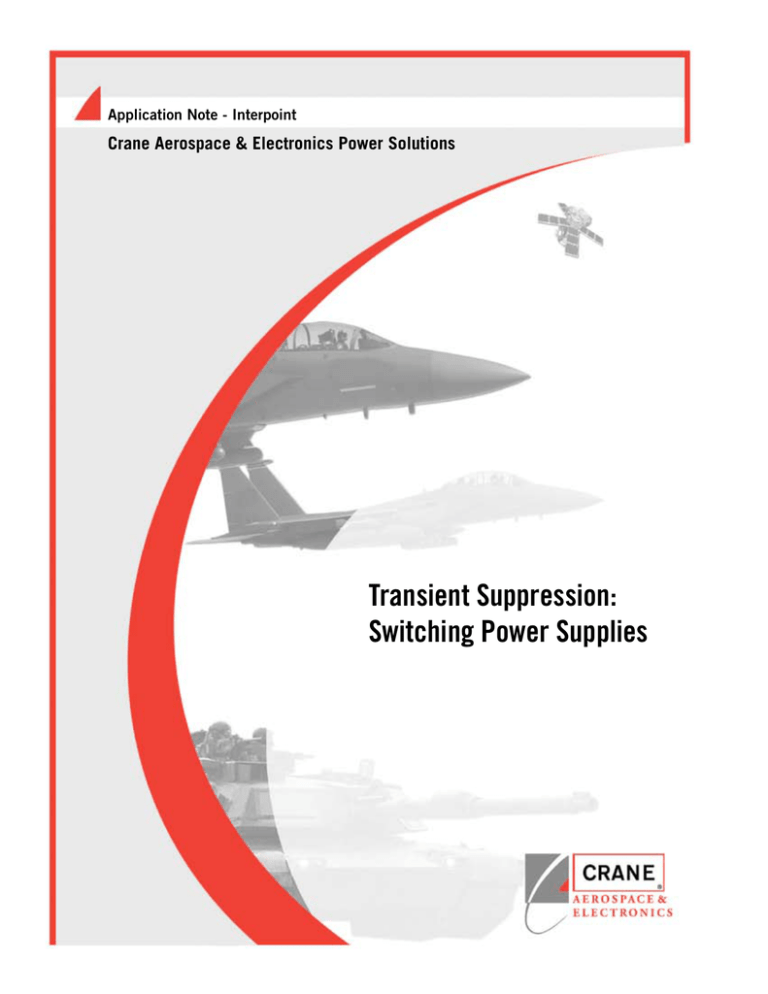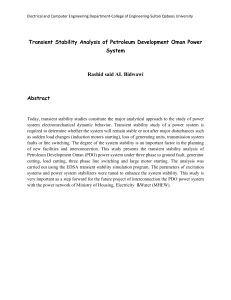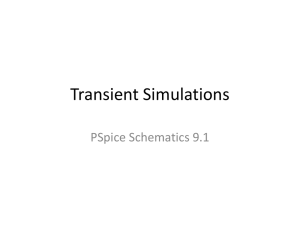
Application Note - Interpoint
Crane Aerospace & Electronics Power Solutions
Transient Suppression:
Switching Power Supplies
Crane Aerospace & Electronics Power Solutions
Transient Suppression: Switching Power Supplies
Application Note
Although the concepts stated are universal, this application note was written specifically for Interpoint products.
Power line transient requirements are a subject which should be
addressed at the beginning of a project, not in the later stages. If
let go till later, there may not be enough room left over for a good
solution. When the time comes, two very important questions
should be asked:
1) What is the transient source impedance? Inquire about both
the real & imaginary parts.
2) What is the volt x second product of the transient?
If the answer is a large source impedance and a small volt x
second product, the problem will be simple to solve. If the volt x
second product is large and the source impedance low, the usual
case, the solution will be more difficult.
The following is written around a 28 volt DC aircraft power bus,
where positive transients should be contained within the 35 to 50
volt area, where the maximum long term transient rating for most
Interpoint power converters is 50 volts. For power converters
which have an 80 volt long term transient rating, suppression
to within less than say 70 volts should be safe, but the output
response of the power supply may require a smaller limit.
The means which are available to suppress voltage transients
are listed in the following:
1) Transorbs, MOV’s. Brute force approach.
2) Shunt capacitors. Will work for high source Z’s.
3) Series inductor to limit DI/DT.
4) Buck regulator for lower voltage longer term transients.
5) Stripper, a series regulator which opens to take the transient
and maintain like a 40 V input to the power supplies for the
transient duration.
6) Combinations of 1, 2, and 3 above.
Figure 1 shows the functional schematic of a switching power
supply with some of the various means of transient suppression
shown at its input. The power supply has an incrementally negative input impedance which must be considered before inserting
any suppression network in series with its input. The negative
input Z is due to the constant power input, at constant load, as a
function line voltage. Simply stated, (Vin x Iin) = K, a constant at
constant load, and Iin = (K/Vin). The decreasing input current with
an increasing input voltage defines a hyperbola, the slope at the
operating point being the negative Z. The input current is largest
at minimum line voltage, and the input Z minimum at this point.
For stable operation, the impedance looking back into any tran-
BUCK REGULATOR
OR
STRIPPER
INPUT
OR
+VOUT
+V
IN
ZS = ?
LIMITER
TRANSIENT
SOURCE
SYN
INH
600 kHz
CONTROLLER
RTN
VOLT x SECOND PRODUCT ?
MAG.
COUPLER
REF
AMP
REF
CASE
MTR SERIES SINGLE OUTPUT TYPE
SCHEMATIC DIAGRAM
Figure 1: Transient Suppression for a Switching Power Supply
Crane Aerospace & Electronics
Crane Electronics Group (Interpoint Brand)
PO Box 97005 • Redmond WA 98073-9705
425.882.3100 • electronics@craneae.com
www.craneae.com
Page 1 of 12
Rev C - 20061206
COM
Crane Aerospace & Electronics Power Solutions
Transient Suppression: Switching Power Supplies
Application Note
period of 10 µs. The 50 ohm source impedance allows it to be
suppressed with a shunt capacitor or transorb across the 28 volt
line. In either case the peak suppression current will not exceed
12 amps, 600 V/50 ohms. Using a 600 V rectangular pulse for
simplicity, a 10 µf low ESR cap placed in shunt with the line will
reduce the peak transient response to about 12 volts on top of
the 28 volt power line. The time constant of the RC will be 50 x
the transient duration, hence the response is 2% of the transient
plus the drop across the ESR. Refer to Figure 4. A transorb will
also work in place of or with the capacitor. A suitable surface
mount device is SMCJ30A from Microsemi Corp. This device
should clamp the line at about 40 volts or below and also has a
sient suppression network must be less than that seen looking
into the switching power supply at minimum line voltage, and
over the control loop bandwidth. It may be advisable to consult
one of the Interpoint applications engineers before finalizing any
suppression network design. Also, refer to Figure 2 which has
some additional information.
SHORT TERM TRANSIENTS
Figure 3 shows some typical transient waveforms taken from
DO-160C and MIL-STD-461C. The top waveform is an approximated damped half sine with a peak of 600 volts and a half
PWM SWITCHING POWER SUPPLY –∆ ZIN
2
PO = VO / RL
INPUT FILTER
+VOUT
+VIN
ZIN
LIMITER
SYNC
INH
LOAD
RL
600 kHz
CONTROLLER
RTN
CASE
REF
AMP
MAG.
NORMAL RES.
R = K = V/I
VXI=K
VIN
V X I = K IS A
HYPERBOLA
∆ ZIN =
COM
REF
ZIN = VIN2 / PIN
PIN = PO /Eff.
–P
P dV
VIN = IN ; IN = 2IN
IIN
IIN dIIN
ASSUMES PO & PIN = K1
–K
∆ZIN = 2 , & IS NEG.
IIN
IIN
PWM SWITCHING POWER SUPPLY STABILITY EXAMPLE
2
ZS =
VS =
LOW Z
SUPPLY
RD
VIN
P O = V O / RL
INPUT FILTER
+VOUT
ZIN
zs
SYNC
INH
LIMITER
LOAD
RL
600 kHz
CONTROLLER
RTN
CASE
Z -Ω
MAG.
COUPLER
ZIN
Jω
REF
AMP
L
RD = DAMPING
fRES
REF
COM
USE SERIES DAMPING
NETWORK OF C AND R
D
TO STABILIZE SYSTEM.
RD =
√ CL FOR Q=1.0
fOSC LOG FREQUENCY
Figure 2: Negative Zin and Damping for Stability
www.craneae.com
Page 2 of 12
Rev C - 20061206
Crane Aerospace & Electronics Power Solutions
Transient Suppression: Switching Power Supplies
Application Note
forward rating of 200 Amps for 1/120 of a second which would
be useful for suppressing negative transients, if any. Alternately,
a forward rectifier in series with the positive line can be used for
this purpose.
The MIL-STD-461C transient of Figure 3 has a low source Z
and will be harder to suppress than the previous case. Unless
defined otherwise, the source Z should be assumed to be zero. A
value of 0.5 ohms is often allowed for testing. For the purpose of
analysis, a value of 0.1 ohms is used.
The 0.15 µs 200 volt rectangular transient could be suppressed
with a low ESR ceramic capacitor, or a transorb. The transient
line current, however, would be very large. Adding a small series
inductor will reduce the current to a manageable level. Since the
transient will substantially appear across the inductor, the rate at
MINIMUM OPEN CIRCUIT VOLTAGE
600
TYPICAL FOLLOW - ON CURVE
10 µs
MAXIMUM
2 µs MAXIMUM
THE WAVEFORM SOURCE IMPEDANCE SHALL BE 50 Ω; THE SPECIFIED VOLTAGE AND DURATIONS ARE
FOR OPEN CIRCUIT CONDITIONS ONLY. THE PEAK VOLTAGE MAY BE SUBSTANTIALLY LOWER WITH THE
EQUIPMENT CONNECTED. THE TESTER SOURCE IMPEDANCE CAN BE VERIFIED BY TESTING WITH A
50 Ω LOAD RESISTOR AND SHOULD PRODUCE ONE HALF OF THE SPECIFIED VOLTAGE ± 10%
DO - 160C - FIGURE 17-1 CATEGORY A VOLTAGE SPIKE WAVEFORM
E
()
E
200 V
()
Time
Volts
Volts
0.5E
Time
t ()
t
()
t 1 = 0.15 µsec
t 2 = 10.0 µsec
NOTE: The test sample shall be subjected to the spike(s) with the waveform shown and
with the specified voltage(s) and pulsewidth(s).
MIL-STD-461C- ACCEPTABLE WAVESHAPES FOR CSO6
Figure 3: Typical Transients – DO-160C and MIL-STD-461C
www.craneae.com
Page 3 of 12
Rev C - 20061206
Crane Aerospace & Electronics Power Solutions
Transient Suppression: Switching Power Supplies
Application Note
resistance of about 0.006 ohms at 23* C. The part number of the
Mag. Inc. core is 77040-A7. The formulas for inductance and flux
density are given below for those who want to try it themselves.
which the current rises will be V/L, where V is the transient peak
voltage L is the inductance in henries, and the rate is in Amps/
second. If we limit the peak current to 10 Amps, the inductance
= (V)(t)/(10) or greater, where t is the pulse duration of 0.15 µs.
The calculated inductance is then 3 µhenries. Either a shunt
capacitor or transorb can be used for the small value inductor to
work against. In this case we will use a 10 µfd capacitor forming
a resonant circuit with the inductor. Based on a Q = 1, the total
damping resistance in series with the L and C should be
= (L/C) = 0.55 ohms to minimize the driving point impedance.
A 0.5 ohm resistor is added in series with the 10 µf capacitor,
and includes its ESR. The circuit models and results are shown
on Figures 5 and 6. Note that the output response to the 200 volt
transient rises to only about 34 volts.
L = 4pµAN2 x 10-7, where
A = the cross sectional area in square meters,
= the magnetic path length in meters,
u = permeability,
N = number of turns
I = Maximum inductor current - Amps,
B = 4pµNI x 10-3
The units of inductance are Henries, and hose of Flux Density
are Gauss.
The inductor has to carry not only the transient current, but also
the normal load current. A sample design on a 0.4” diameter Kool
Mu toroid will carry 20 amps at a flux density of about 80% of
saturation. The inductor has 7 turns of #22 AWG wire with a DC
50Ω ZO
600 V
+
10 µF
28 V
0.1 Ω
The 10 µs 200 volt transient will require a much larger inductor
if the same method of suppression is used. If we want to limit
the transient current to 20 amps for example, then the inductor
value will be 100 µhenries minimum. Here, we will use a
transorb to clamp the line voltage and select a 47 µf capacitor
TRANSIENT
RESPONSE
VOLTAGE
Transient Response (Vout)
Transient Voltage - KVin
.65
.52
.39
.26
.13
0.00
50 Ω 600 V 10 µsec Transients
50.00
40.00
30.00
20.00
10.00
0.00
5100
5200
Time (µs)
5300
Figure 4: Transient Response
www.craneae.com
Page 4 of 12
Rev C - 20061206
5400
5500
Crane Aerospace & Electronics Power Solutions
Transient Suppression: Switching Power Supplies
Application Note
is Mag. Inc, part number 77438-A7 with an O.D. of 1.85˝ and a
thickness of 0.71˝. This inductor would be suited to a 150 watt
system where the max operating current at 28 volts is 5+ amps,
and 10 Amps at low line.
to set the driving point impedance to less than two ohms. The
damping resistor is 1.4 ohms as calculated from (L/C). The
transient response and driving point Z graphs are on Figures 7
and 8. The transorb breaks over at 39 volts and has a 0.5 ohm
dynamic resistance. A similar surface mount part is SMLJ30A. If
the driving point Z needs to be lower, make the shunt capacitor
larger and recalculate the damping resistor. For example if
the capacitor is increased to 470 µf, the driving point Z can be
lowered to below 0.5 ohms, and the transorb can be eliminated.
For a smaller system where the normal operating current is less
than say 1.5 amps at 28 VDC, the inductor can be somewhat
smaller. If the transient current is restricted to less than 5 amps,
then the series inductance becomes 400 uh or greater. If we
keep the 47 µf capacitor, the optimum damping resistor becomes
2.8 ohms. The transient response is much the same as Figure 7
except the amplitudes are smaller. The driving point impedance
is about 4 ohms at the resonant peak, and 2.8 ohms thereafter.
The 400 uh series inductor has 51 turns of #22 AWG wire with a
The inductor of this example will carry 30 amps, 10 for normal
operation and the additional twenty for transient suppression.
The inductor is wound on a Kool Mu toroid with 19 turns of #11
AWG with a resistance of about 0.005 ohms at 23˚ C. The core
3 µH
0.1 Ω
200 V
10 µF
+ 28 V
0.5 Ω
VLINE TRANSIENT
RESPONSE
0.001 Ω
ILINE
.25
Kilivolts
.20
.15
.10
.05
0.00
CS06 0.15 µsecTransient - Line Voltage Response
40.00
Volts
32.00
24.00
16.00
8.00
0.00
CS06 0.15 µsecTransient - Line Voltage Response
25.00
Amps
15.00
5.00
-4.99
-15.00
-25.00
5045
5050
5055
Time in µs
Figure 5: Transient Response
www.craneae.com
Page 5 of 12
Rev C - 20061206
5060
5065
Crane Aerospace & Electronics Power Solutions
Transient Suppression: Switching Power Supplies
Application Note
resistance of 0.102 ohms at 23° C. The toroidal core is Kool Mu
77930-A7 with an O.D. of 1.06” and a thickness of 0.44”. This is
smaller than the previous example, but possibly larger than what
is desirable. A stripper might be considered as an alternate solution. This is covered in later paragraphs.
LIMITED ENERGY TRANSIENTS
MIL-STD-1275A has a transient with an energy limit of 0.015
Joules, or 0.015 watt seconds. The transient is shown on Figure
9, and occurs over a time period of 1 millisecond. The total
power then won’t exceed (.015)\(.001) = 15 watts, which can be
clamped with a small transorb at 40 volts or so. A shunt capacitor
could also be used for suppression, and the minimum value can
be calculated from energy storage equations as shown in the
following.
Cmin = (2 x Energy)/(Vmax2 – Vline2)
= (0.03)/(402 - 282 ) = 37 µF
DROPOUT TRANSIENTS
During dropout transients, the power line can be held up with
a battery or pre-charged capacitor connected to the power line
through a reverse rectifier. Interpoint has holdup modules which
charge up an external capacitor to about 40 volts, and then
connect it to the internal power line through a FET switch when
dropout occurs. These devices are HUM-40 and HUM-70. The
“HUMMER” (HUM-40 and HUM-70) datasheet has a wealth
of technical information on the subject and when the parts are
used in an application, a significant reduction in the volume of
capacitance needed will result. Where a capacitor is to be used
3 µH
10 µF
Z
0.1 Ω
D
0.5 Ω
DRIVING POINT Z VS FREQ - TRANSIENT REJ. NETWORK
Case = 1
Temperature = 27
Z - OHMS
D
10.0
1.0
0.1
1K
10K
100K
Frequency in HZ
Figure 6: Transient Response
www.craneae.com
Page 6 of 12
Rev C - 20061206
1M
10M
Crane Aerospace & Electronics Power Solutions
Transient Suppression: Switching Power Supplies
Application Note
100 µH
0.1 Ω
200 V - 10 µsec
47µF
+ 28v
1.4 Ω
39 V
LINE VOLTAGE
TRANSIENT
RESPONSE
0.5 Ω
0.001Ω
I LINE
.25
KIilivolts
.20
.15
.10
.05
0.00
CS06 0.15 µsecTransient - Line Voltage Response
50.00
Volts
40.00
30.00
20.00
10.00
0.00
CS06 0.15 µsecTransient - Line Voltage Response
25.00
Amps
15.00
5.00
-4.99
-15.00
-25.00
5045
5050
Time in µs
5055
Figure 7: Transient Response
www.craneae.com
Page 7 of 12
Rev C - 20061206
5060
5065
Crane Aerospace & Electronics Power Solutions
Transient Suppression: Switching Power Supplies
Application Note
LONG TERM TRANSIENTS
for holdup, the minimum value of capacitance required can be
calculated from:
C = 2P∆T/(VCH2 - VLL2 ), where,
P
= input power in watts,
∆T = dropout time in seconds,
VCH = holdup capacitor voltage at dropout,
VLL = low line voltage where power supply, loses regulation, usually 12 to 16 V.
Long term transients, as defined here, are those which have a
duration of 50 to 100 milliseconds, and then return to the normal
28 volt line voltage in 50 milliseconds to a second or more.
Examples are the 80 volt transient of MIL-STD-704A, and the
100 volt transient of MIL-STD-1275A. The latter has a defined
source impedance of 0.5 ohms. The 704A transient does not
have a defined source Z, and the value could range from a few
millohms to a half ohm for individual systems. Refer to Figure 10
for examples.
Transients like these have too large a volt second product to
be suppressed by conventional energy storage means as in the
previous examples. The L and C components would be much
to large. This would also be generally true for transients having
L = 100 µ H
47 µF
Z
0.1 Ω
D
1.4 Ω
Driving Point Z - 100 µH & 47 µF with 1.4 Ω damper
Temperature = 27
Case = 1
Z - OHMS
D
10.0
1.0
0.1
1K
10K
100K
Figure 8: Transient Response
www.craneae.com
Page 8 of 12
Rev C - 20061206
1M
10M
Crane Aerospace & Electronics Power Solutions
Transient Suppression: Switching Power Supplies
Application Note
a low source Z and durations in excess of a few tens of µs.
Transorbs can be used for these as well as the longer duration
transients, but they may be large, and safe energy as well as
peak current ratings need to be observed.
A buck switching regulator is the most efficient means of
rejecting the long term transients, but it generates its own noise
and requires a finite time to get up and running, typically about a
millisecond. For fast turn on transients, this would not work well.
The stripper is the best overall solution. The Interpoint FM-704A
combines a stripper and conducted interference EMI filter. The
stripper uses a pair of high line N channel power FETS, and a
charge pump to obtain gate enhancement above the +28 volt
line. Refer to the data sheet for the functional schematic and
other useful information. Two additional examples are shown on
Figure 11. One of these uses an N channel FET in the return
line, and the other uses P channel FETS in the +28 volt high line.
The stripper is a fast voltage regulator, where in normal operation the FET is in full enhancement with its Rds in series with
the power line. When the transient comes along, the stripper
regulates its output in the 40 to 50 volt area, with the balance of
the transient appearing across the series FET. The FET current
during the transient is the load current at the regulated output
voltage. In the case of a switching power converter load, where
the regulated output is 45 volts, the current will be about 60%
of its value at 28 volts. The power dissipated across the FET as
well as the total energy absorbed during the transient need to be
considered in the design of a stripper.
INDUCED CURRENT TRANSIENTS
Induced current transients caused by EMP or high level signals
in adjacent wiring can be common mode, differential mode, or
a combination of the two in nature. The example of Figure 12
is from MIL-STD-461C, method CS11, and is common mode
in nature. This transient can be suppressed with good quality
MAXIMUM ENERGY CONTENT:
15 millijoules
+VE
250
200
150
LIMITED ENERGY TRANSIENT
FROM MIL-STD-1275A
100
50
STEADY STATE VOLTAGE
PEAK
VOLTS
0
50
100
150
200
250
–VE
.001
.01
.1
DURATION (milliseconds)
Figure 9: MIL-STD-1275A Limited Energy Transient
www.craneae.com
Page 9 of 12
Rev C - 20061206
1.0
Crane Aerospace & Electronics Power Solutions
Transient Suppression: Switching Power Supplies
Application Note
ceramic capacitors from both the +28 volt and the return line to
the power converter case. In case of unbalance, a capacitor can
be placed across the lines also. The minimum capacitor value is
easily calculated once a maximum acceptable voltage deviation
is defined. If we assume a maximum voltage deviation of 1.0 volt
is allowable, the minimum capacitance is 2.7 µf. Refer to Figure
12 for the details. The capacitors can also be paralleled with
which may be effective in suppressing lightning induced transients.
Notes: Loci shown as solid line includes ripple.
Surge Source Impedence
Surges originate from a source impedence
of approximately 500 milliohms. UK loci excludes
commutating/ignition peaks.
Loci of US Surge Measurements
100
90
Loci of UK Surge Measurements
80
PEAK
VOLTS
70
60
50
40
30
20
10
0.001
0.01
0.1
Recovery Time (seconds)
Figure 10: MIL-STD-1275A Low Impedance Transients
www.craneae.com
Page 10 of 12
Rev C - 20061206
1.0
Crane Aerospace & Electronics Power Solutions
Transient Suppression: Switching Power Supplies
Application Note
MIL STD 1275A TRANSIENT STRIPPER
+28Vout
+ 28V
3.6K
470pf
.01f
33V
30K
LIMITED
TO 40V
.01f
^
510
ZTX-750
2.4k
INH
OUTPUT RTN
N CHANNEL
.022f
10V
FET
2N2222
1K
51
1K
2N2222
RTN
FUNCTIONAL SCHEMATIC DIAGRAM
POWER CONDITIONER MODULE
+
+
2 EACH
IRF9241
IN PARRALLEL
v
V
+
IN
V
OUT
100 F
50V
INCREASE
40V - 45V LIMIT
V
1
OUT
1
45 VOLTS
V IN
Figure 11: Transient Stripper
www.craneae.com
Page 11 of 12
Rev C - 20061206
INCREASE
max
Crane Aerospace & Electronics Power Solutions
Transient Suppression: Switching Power Supplies
Application Note
From MIL-STD-461C
Maximum Common Mode Current (Amps)
I
MAX
100.
10.
+ 28LINE
1.
RTN
.01
.1
1.
Frequency (MHz)
10.
C
SWITCHING POWER
COVERTER
RTN
C
.16
.1
.01
+28
C
CASE
CMIN = IMAX
∆Vω
100.
ω = 2πf
ICABLE (t) = 1.05 IMAX e-( πft/Q) SIN (2πft)
MAX
I
CABLE (t)
CABLE CURRENT
I
where,
TIME
ICABLE
(t) = common mode cable
current in amps
f = frequency, hertz
t = time, seconds
Q = decay factor
Figure 12: Induced Current Transient – MIL-STD-461C, Method CS11
Transient Suppression Rev C - 20061206
All information is believed to be accurate, but no responsibility is assumed for errors or omissions. Interpoint reserves the right to
make changes in products or specifications without notice. Copyright © 1999 - 2006 Interpoint Corporation. All rights reserved.
Page 12 of 12




